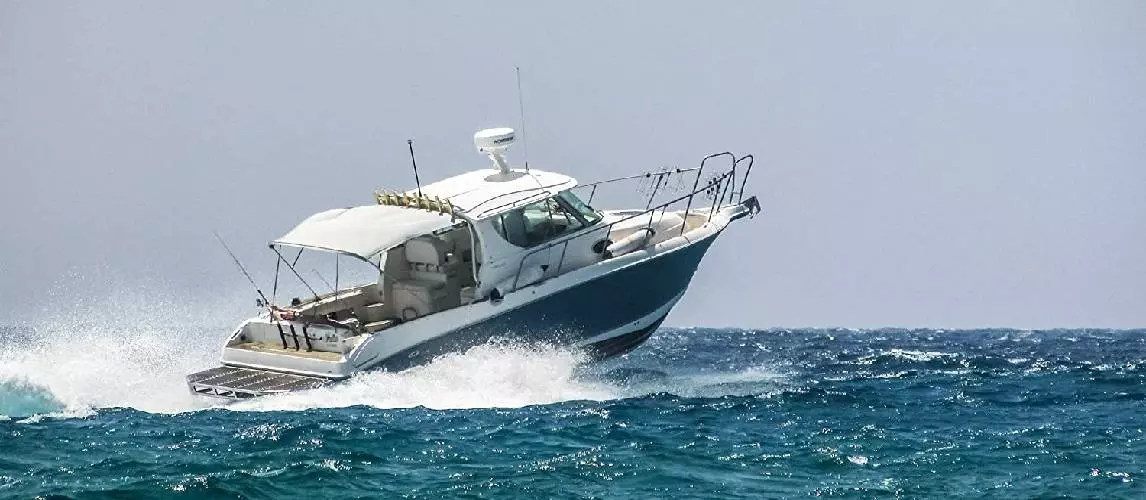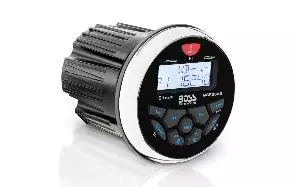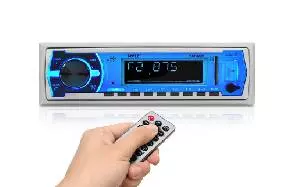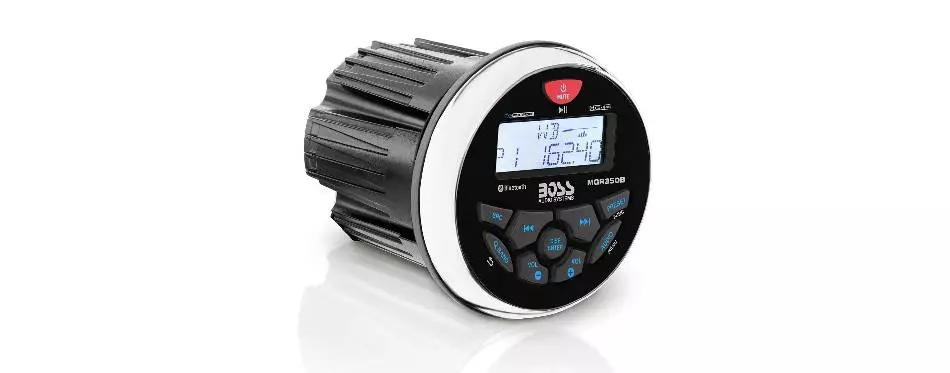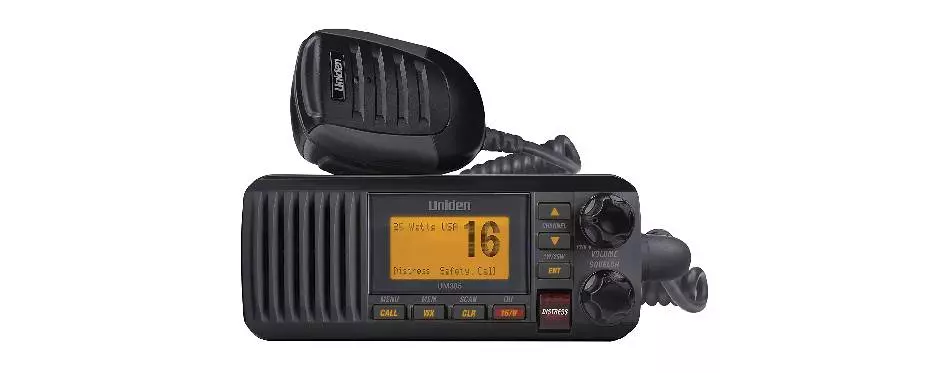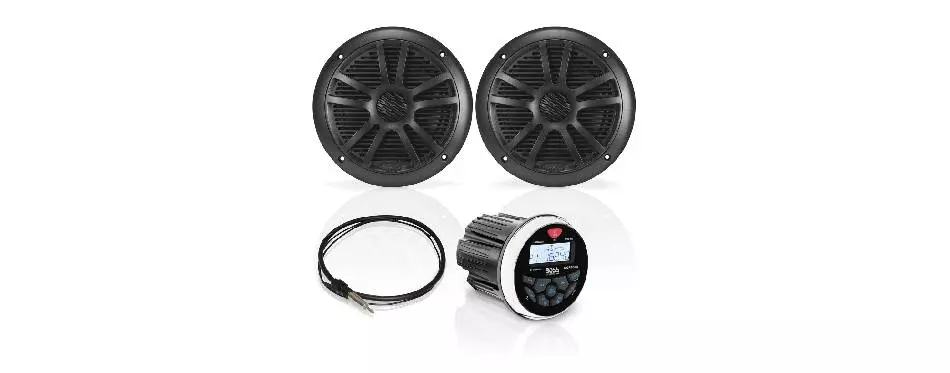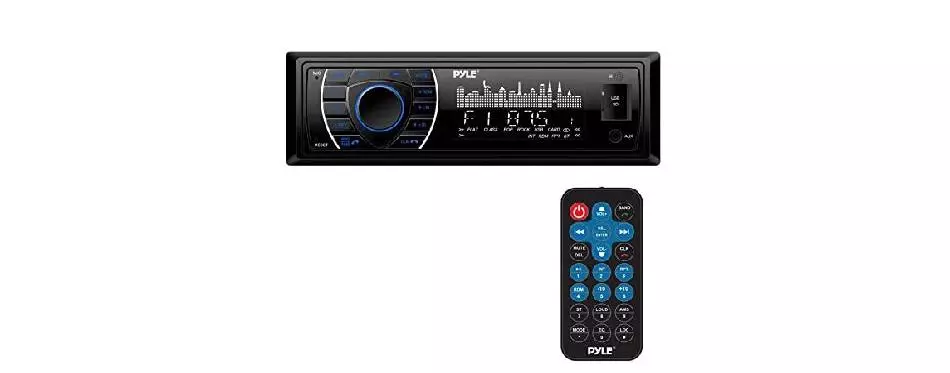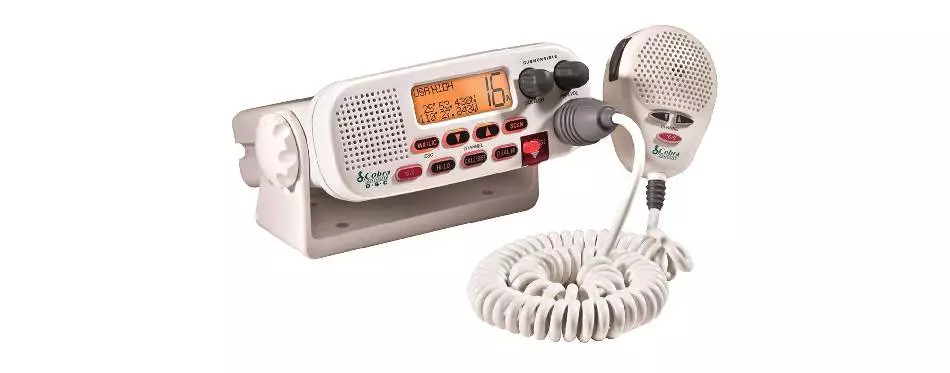The boating world has come a long way from hoisting the sail and declaring your colors to passing ships. Nowadays, if your ship isn’t equipped with a high-grade radio, it isn’t really safe to take on open water. Even if you aren’t planning to hit the open ocean, your vessel requires the support of a quality radio system. It’s about more than communication—your marine radio should give you access to both AM and FM stations, along with emergency alerts. But it isn’t about taking any old radio and mounting it to your boat. Marine radios have a lot more demanding requirements.
Among these is the necessity of waterproof features, VHF capacity, and (ideally) GPS components. To make sure your next boating trip, whether for work or recreation, goes smoothly, you need a high-quality radio system. This list breaks down the best marine radios on the market, along with everything you need to know to find the perfect fit.
The Best Marine Radios
The BOSS Marine Gauge Receiver is a great place to start if you are looking to enhance the function of your boat. Since it is so small in size, you can install it on just about any marine vessel. It features a small LCD that highlights the status of the radio at any given time. With Bluetooth compatibility, you can opt to play music wirelessly or through the USB port. It can connect to the rear and front subwoofer, letting you play off the speakers already in the boat. It’s tough enough to weather difficult on-water conditions, thanks to the waterproof design and overall durable structure. It’s treated to prevent issues with ultraviolet radiation, letting you use it over the long term.
Although this radio works well in marine settings, it lacks a transmitter. As such, it is better for lake trips since a sea-worthy radio would need a transponder.
- Connects via Bluetooth
- 240-watt output capacity
- Remote control operation
- Includes four channels
- Brand BOSS Audio Systems
- Model MGR350B
- Weight 1.95 pounds
Entirely waterproof structure
Lightweight and easy to install
Protected against UV radiation
Doesn’t incorporate a transmitter
Lacks CD/DVD capacity
Relatively small display
Coming at a friendly price point for any budget, this bright and effective radio is built specifically for marine use. Installing directly into the deck of your boat, you can connect to this system via USB or Bluetooth. The powerful receiver can also take calls, letting you stay in touch while you’re out on the water. It comes preloaded with AM/FM radio connectivity, among other DIN standard applications. The memory can hold on to as many as 30 stations, letting you quickly access relevant information. Featuring a 12-volt electrical system and powerful wattage output, this model is ideal for houseboats and casual vessels alike.
Keep in mind that this marine radio can be a bit tricky to install. Also, the remote is not waterproof, so it’s best to store it in a water-resistant container or have a backup, just in case it falls into the water.
- Includes a prominent LCD screen
- Installs directly into dash
- 12-volt electrical system
- Output of 300 watts
- Brand Pyle
- Model PLMRB29W
- Weight 1.39 pounds
Includes user-friendly remote
Connects via USB and remotely
Independent bass and treble controls
Able to answer calls via Bluetooth
Lacks a DVD/CD system
Remote is not waterproof
Can be tricky to install
This heavy-duty radio system is built specifically for use on open water. It features the essential marine broadcast channels that let you travel internationally in safety. Entirely waterproof and rugged by design, it can withstand the wear and tear of open water. Compatible with all types of receivers (including GPS), this powerful radio gives you access to AM/FM and all other VHF frequencies. By letting you hear the National Oceanic and Atmospheric Administration weather alert station, you can plan ahead and ensure the safety of the boat (and crew). Wireless and commanding, this sturdy radio includes a moderately-sized, backlit screen and 30-channel memory to keep you equipped for whatever the ocean throws at you.
If you’ve never used one of these radios before, it can take a bit of getting used to. Be sure to read the instructions thoroughly and familiarize yourself with the functions before setting sail.
- Includes NOAA weather alert
- Complete with memory channel scan
- Fixed-mount VHF radio
- Works internationally
- Brand Uniden
- Model UM385BK
- Weight 3.55 pounds
Durable design and structure
Includes powerful transponder
25-watt fixed system
Comes at a higher price point
Requires lengthy installation
Has a hefty learning curve
This handheld radio eliminates any issues with compatibility or installation. Despite its small size, this is one tough model—it floats in the water and is rated to be safely submerged up to one meter for half an hour. Compatible with all international channels, it is designed to receive frequencies between 76 and 108 megahertz. With programmable functions and a speaker jack, this radio can hold up to the most demanding standards. By using rechargeable batteries, you can always stay in power wherever you go. It’s compatible with a 12-volt DC charger and also lets you use a wall outlet as needed. Coming with an antenna and instruction manual, this marine radio equips you for open waters.
Although this radio is handy, it is less heavy-duty than built-in models. Consider getting it as a backup; or, if it is your primary radio, look into getting a pair of these radios.
- Comes as a single handheld radio
- Tunes to VHF radio
- Works between 76 and 108 MHz
- Bold, well-backlit LCD screen
- Brand Standard Horizon
- Model STH-HX210
- Weight 0.9 pounds
Lightweight and easy to grip
Can be submerged up to a meter
Long-lasting battery charge
Only comes with one in a set
Vulnerable to impact damage
Requires battery recharging (no replaceable option)
This marine radio comes with a receiver and two powerful speakers to be installed directly into the dash. With USB and Bluetooth input options, you can use it for radio communications or to play a soundtrack. Each of the two 6.5-inch speakers can provide clear and crisp audio, letting you stay apprised of the weather or rock out to music. It connects to the subwoofer already on your boat so that you get full-bodied, pleasant sounds when on deck. With user-friendly controls and a crisp screen, this radio makes a great addition to your marine vessel.
While this radio is compatible with all the essential stations to keep you safe on the water, it still lacks a transmitter. Also, it may overheat depending on where you install it.
- Includes powerful speakers
- Tunes to the NOAA weather station
- Can connect to USB and Bluetooth
- Entirely waterproof structure
- Brand Boss
- Model MCKGB350B.6
- Weight 6.4 pounds
Relatively easy to install and use
Speakers provide crisp audio
Bluetooth adds extra functionality
Takes up more space with speakers
May overheat depending on placement
Lacks a CD or DVD player
This marine radio is equipped with a digital receiver for both AM and FM frequencies. It can connect via Bluetooth or USB so that you can set up a soundtrack for your trip. With the ability to add on other devices, this radio makes a great starting point for new boat owners. All parts of it are easy to control, thanks in large part to the light-up button controls. A bold LCD screen keeps you in the know about the radio’s status. Linking to quality speakers, this system gives you crisp audio while you’re out on the water. User-friendly and durable, it makes a terrific addition to your boat’s dash.
Keep in mind that this marine radio is only meant for recreational use because it lacks features like the NOAA weather station and a transponder system. It is also vulnerable to scratches.
- DIN-style boat radio system
- Installs directly to deck
- 300-watt output system
- Brand Pyle
- Model PLRMR27BTB
- Weight 1.33 pounds
Connects via Bluetooth 12-volt radio receiver system
Configured for USB connection
Wide frequency compatibility
Lacks a transponder system
Lacks NOAA weather frequency
Vulnerable to scratches
This radio installs directly into the dash, fixing securely onto any boat. It incorporates both a receiver and a transmitter, letting you communicate securely regardless of where you are. The radio is equipped to receive 10 NOAA weather alert channels to help you through emergencies. With a noise-canceling microphone, you can always reach out for assistance. In terms of the screen, the bright LCD highlights the channel you’re on. Paired with the backlit controls, it’s extremely easy to take command of the radio regardless of your experience level. Offering 25 watts of output power, this radio improves safety while you’re out on the water.
Due to the advanced features of this radio, it comes at a higher price than most other models. Also, it can be time-consuming to install it in your boat.
- Fixed-mount VHF radio
- Includes noise-cancelling mic
- Receives and transmits a signal
- 25 watt radio output
- Brand Cobra
- Model MR F45-D
- Weight 2.6 pounds
Receives ten weather channels
Entirely FCC compliant
Digital selective calling feature
Higher end of pricing spectrum
Time-consuming to install
Mounting hardware vulnerable to rust
Best Marine Radios Buying Guide
Getting a new marine radio can be a bit more complicated than outfitting your car’s sound system. Technology that’s meant for use around water has to hold up against more straining environmental risks like ultraviolet radiation, as well as salt and freshwater. It needs to be powerful enough to supply clear audio over the interference of the waves (and the boat engine). Maybe it doesn’t need to be as strong as an air horn, but it definitely must be loud.
If you’re taking the boat out on the ocean, then you need a VHF (very high frequency) radio for communications. Conversely, if you plan to pull a water skier or float around a lake, you can opt for a more basic audio system. As long as you take your time when making your choice, you can reap the most benefits from the radio.
The Advantages of Owning a Marine Radio
Having a marine radio is more than a convenience; it is necessary for your safety, especially if you plan to go on the ocean. A VHF radio gives you access to a wide range of frequencies, including emergency alerts and weather stations, to help you stay protected while you sail.
Also, heavier-duty radios include a transponder system, meaning that you can both receive and transmit signals, facilitating communication. As you travel, being able to touch base with your surroundings is particularly important. Plus, many radios also incorporate a GPS tracker so that you can always pinpoint your location. There are more advantages, too.
- A good marine radio gives you crisp audio quality and has an output wattage that can compete with surrounding noise.
- The ability to connect to Bluetooth and USB lets you plan a soundtrack for your boat trip.
- Marine radios are designed to be extremely durable, making them one of the more long-lasting pieces of audio equipment.
- This type of radio is waterproof so that it won’t suffer any damage from rain or surrounding water.
- Resistance to ultraviolet radiation keeps the radio working properly and prevents damage.
- Access to a wide range of frequencies gives you access to weather alerts and other essential information.
Types of Marine Radios
To make the most out of your marine radio setup, it’s important to find the correct type for your needs. If you’re looking for an addition to your lake boat, then it is less demanding. However, ocean vessels require more advanced features from their radios. Think about where you plan to use the radio as you seek out the type that’s best for your boat.
Handheld
A common type of marine radio is a two-way handheld system. These are easy to move around with, letting you communicate across the vessel itself. Typically, boat operators will require more than one handheld radio so the whole crew can be equipped. Many of these radios have VHF capacity and can tune into a wide range of frequencies, including weather alerts.
While this type of radio is easy to use, it is best as a supplemental radio that works either as a backup or in conjunction with an in-dash system. The added convenience factor is significant, though these radios (unlike hardwired models) lose charge over time.
In-Dash VHF
This is the most prevalent type of marine radio, wiring directly into the electrical system in the boat itself. Coming in multiple sizes, these radios incorporate a backlit LCD screen to keep you apprised of the radio’s status. Typically, the push-button controls scan FM and AM channels while the boat’s speakers relay the sound.
To be a viable radio for your boat, the in-dash model should have access to NOAA weather alerts. It’s helpful to look for FCC approval when assessing the value of these marine radios. Higher-end models will include a transponder, letting you both take in signals and relay them.
Basic Audio
This type of marine radio is best for less demanding situations like trips on the lake. Usually, these will install directly into the dash of the boat, wiring into the electricals. Like VHF models, it has an LCD screen and often includes a remote control. Although some come with speakers, many play off the subwoofers in the boat itself.
When looking at this type of radio, check for both Bluetooth and USB input modalities so that you get more options for playing music (the main feature of these radios). To check how powerfully it will supply audio, look into the system’s wattage: the higher this metric, the better the sound.
What to Consider When Buying a Marine Radio
As you look into the different marine radio options, there are a few things to keep at the forefront of your mind. It all comes down to the type of boat you captain and where you plan to sail it: this will dictate the ambient noise against which the radio must contend. It will also relate to the features you need from the radio itself. Among the many considerations are:
- Fit and installation: Usually, boats include slots to fit a radio. Check for DIN-sized notations on your radio to simplify installation and make sure that it fits. If you want something bigger, think about how you plan to make adjustments to the dash to accommodate it.
- Ability to expand: If you plan to add to the system down the line, take a moment to check if the radio can support other devices. Look out for added output connections so you can hook up additional speakers, amps, and subwoofers as time goes by.
- AUX compatibility: Most modern radios do not support CDs or DVDs, instead opting for a plug-in part that connects to your other devices. Look for a USB port so that you can hook up your phone and your MP3 player to play your tunes. It’s important to note that AUX is not the same as Bluetooth.
- AM/FM capacity: To ensure that you are not getting an audio-only model (that relies on plug-ins or Bluetooth to play), make sure that it has AM/FM capacity. Look at the scanner quality and the range to make sure it can perform as you need it to.
The Most Important Features of Marine Radios
After you’ve thought through what type of radio you need and have narrowed down a few models for your shortlist, it’s time to look at the essentials. By analyzing these specific features, you can be sure that the radio will work properly. Though there is a lot of demand placed on the radio, you can make easier work of finding the right model as long as you check for these features.
Output
The output of your radio is an essential component of the overall sound system. It is measured in watts, referred to specifically as output wattage. The higher this number, the more powerful the radio will be. Generally, radios with a higher wattage will hardwire directly into the boat, installing in the dash.
More power means louder sounds, a critical feature on ocean-bound vessels because there is so much noise with which to contend. The output is where it connects to the speakers and the electricals; so, if you plan to add onto the system later, look for extra output components.
Radio Capability
The next feature to investigate is the radio capability itself. This feature refers to the system’s abilities, including whether it works as a receiver and transmitter or only a receiver. Look at whether it is a VHF model, ensuring that it can access all the relevant channels.
Provided it has this notation, the radio will have access to the NOAA weather alert station and the other AM/FM stations in the area. So long as it can register this information, it has the most basic safety features. Ocean vessels require a transponder system so that you can signal for help if needed.
Input
Finally, look at the input features on the marine radio: this refers to how it takes in information. Provided you have already determined that it can scan for relevant radio stations, you can move on to investigating its AUX capacity. This is basically the plugin that enables you to attach your music system and curate a playlist.
Another worthy feature to look for that falls under this category is Bluetooth capacity, which lets you link remotely to the radio and command it using your smart device. Though this is less important for ocean craft, it is a helpful feature on lake boats.
Care and Maintenance for Marine Radios
To extend the lifespan of your marine radio, it is essential to care for it properly. The first part of this process occurs during installation: be sure to read through the manual thoroughly and follow the setup procedure. It’s better to take a few extra minutes up front instead of risking tech issues further down the line.
Provided it’s installed correctly, most of the maintenance should be fairly straightforward. Wipe down the surface whenever possible and keep the ports clean and free of debris. From there, simply check on it before you set sail. Routine radio maintenance involves running diagnostics. Test all the functions to make sure that everything is in working order. If there is an issue, you can deal with it at that time.
- Keep it clean and free of debris, much as you would your motorcycle radio.
- Avoid overworking the speakers to prevent the speaker system from breaking.
- If your radio doesn’t hardwire to the boat and is separate like an ATV sound bar be sure to store it securely.
- For handheld radios, ensure that you have spare batteries on hand in case it dies.
- Always check on the function of your radio before you set sail to make sure everything works.
Best Marine Radio FAQ:
Especially if you are new to the world of boating, it is normal to have some questions. Gathering all relevant information before choosing your radio is not only prudent, it’s essential. To help you in your fact-finding mission, we’ve addressed some of the most commonly asked questions below.
Many companies make quality VHF marine radios, including BOSS, Pyle, and Uniden.
VHF (very high frequency) radios use a frequency range between 156 and 174 megahertz.
No, especially if you are using marine-specific wavelengths, you shouldn’t use marine radios on land for security reasons.
Our Top Pick
After careful consideration, we’ve named the BOSS Marine Gauge Receiver as our top choice. It is created by a well-reputed manufacturer, is made to install securely into the dash of your boat, and receives a wide range of frequencies. Connecting via USB and Bluetooth, this powerful radio system is suitable for marine enthusiasts of all experience levels.
Final Thoughts
Now that you’re familiar with the nuances of marine radios, you can make your pick—it could be the BOSS Marine Gauge Receiver or the affordability of the Pyle Marine Bluetooth Radio.
Sources:
- Marine VHF Radio – Wikipedia
